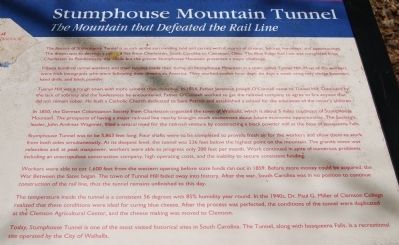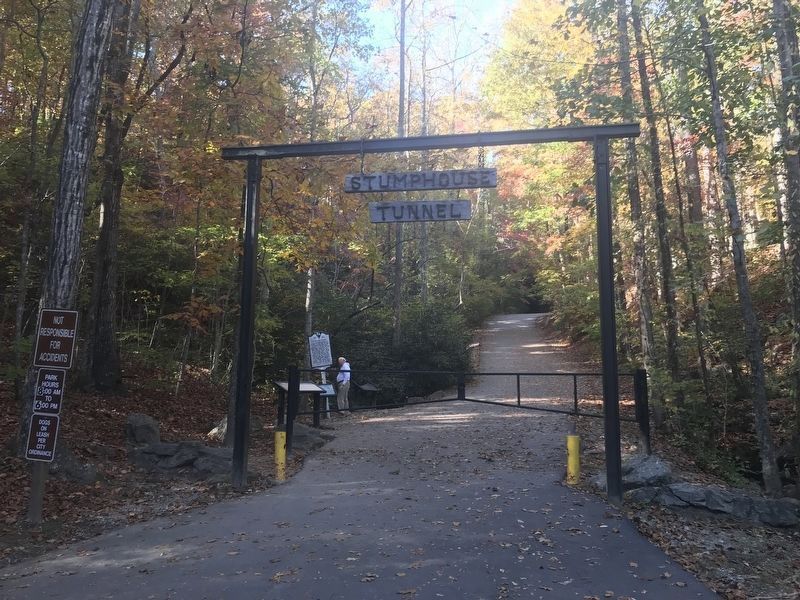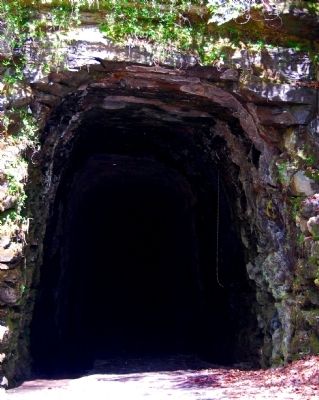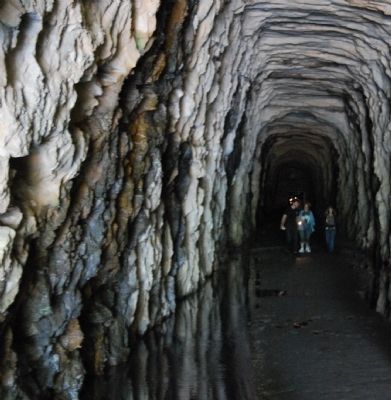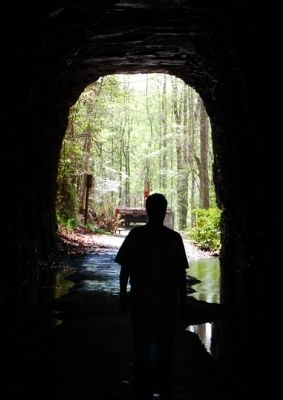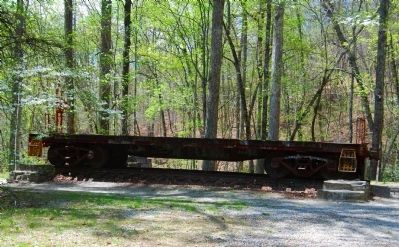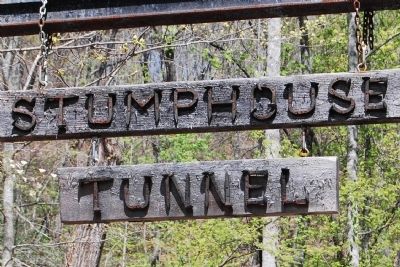Walhalla in Oconee County, South Carolina — The American South (South Atlantic)
Stumphouse Mountain Tunnel
The Mountain that Defeated the Rail Line
The history of Stumphouse Tunnel is as rich as the surrounding land and carries with it stories of dreams, failures, hardships, and opportunities. The dream was to develop a railroad line from Charleston, South Carolina to Cincinnati, Ohio. The Blue Ridge Rail Line was completed from Charleston to Pendleton by the 1850s but the granite Stumphouse Mountain presented a major challenge.
Fifteen hundred tunnel workers and their families made their home on Stumphouse Mountain in a town called Tunnel Hill. Most of the workers were Irish immigrants who were following their dreams to America. They worked twelve hour days, six days a week using only sledge hammers, hand drills, and black powder.
Tunnel Hill was a rough town with more saloons than churches. In 1854, Father Jeremiah Joseph O'Connell came to Tunnel Hill. Dismayed by the lack of sobriety and the lawlessness he encountered, Father O'Connell worked to get the railroad company to agree to fire anyone that did not remain sober. He built a catholic Church dedicated to Saint Patrick and established a school for the education of the miner's children.
In 1850, the German Colonization Society from Charleston organized the town of Walhalla, which is about 6 miles southeast of Stumphouse Mountain. The prospects of having major railroad line nearby brought much excitement about future economic opportunities. The Society's leader, John Andreas Wagener, filled a critical need for the railroad venture by constructing a black powder mill at the base of Issaqueena Falls.
Stumphouse Tunnel was to be 5,863 feet long. Four shafts were to be completed to provide fresh air for the workers and allow them to work from both sides simultaneously. At its deepest level, the current tunnel was 236 feet below the highest point on the mountain. The granite stone was relentless and, at peak manpower, workers were able to progress only 200 feet per month. Work continued in spite of numerous problems including an unscrupulous construction company, high operating costs, and the inability to secure consistent funding.
Workers were able to cut 1,600 feet from the western opening before state funds ran out in 1859. Before more money could be acquired, the War Between the States began. The town of Tunnel Hill faded away into history. After the war, South Carolina was in no position to continue construction of the rail line, thus the tunnel remains unfinished to this day.
The temperature inside the tunnel is a consistent 56 degrees with 85% humidity year round. In the 1940s, Dr. Paul G. Miller of Clemson College realized that these conditions were ideal for curing blue cheese. After the process was perfected, the conditions of the tunnel were duplicated at the Clemson Agricultural Center, and the cheese making was moved to Clemson.
Today, Stumphouse Tunnel is one of the most visited historical sites in South Carolina. The Tunnel, along with Issaqueena Falls, is a recreational site operated by the City of Walhalla.
Erected by South Carolina Heritage Corridor.
Topics and series. This historical marker is listed in these topic lists: Man-Made Features • Notable Events • Notable Places • Railroads & Streetcars. In addition, it is included in the South Carolina Heritage Corridor series list. A significant historical year for this entry is 1854.
Location. 34° 48.617′ N, 83° 7.392′ W. Marker is in Walhalla, South Carolina, in Oconee County. Marker is on Stumphouse Tunnel Road. Marker is located near the walkway to the tunnel opening. Touch for map. Marker is in this post office area: Walhalla SC 29691, United States of America. Touch for directions.
Other nearby markers. At least 10 other markers are within 4 miles of this marker, measured as the crow flies. Stumphouse Tunnel (within shouting distance of this marker); Issaqueena Falls (approx. ¼ mile away); a different marker also named Issaqueena Falls (approx. ¼ mile away); South Carolina National Heritage Corridor (approx. ¼ mile away); Andrew Pickens Ranger District / Oconee County (approx. ¼ mile away); Mountain Rest School / Hillbilly Day (approx. 2.3 miles away); Chauga Town (approx. 3.4 miles away); Oconee Town (approx. 3.8 miles away); The Oconee Waterwheel (approx. 3.9 miles away); Oconee Station / Oconee County (approx. 3.9 miles away). Touch for a list and map of all markers in Walhalla.
Also see . . .
1. Stumphouse Mountain Tunnel. Stumphouse Mountain Tunnel in Oconee County, South Carolina is an uncompleted railroad tunnel for the Blue Ridge and Atlantic Railroad in Sumter National Forest. (Submitted on January 4, 2009, by Brian Scott of Anderson, South Carolina.)
2. Stumphouse Tunnel - Issaqueena Falls. You Tube video of the tunnel. (Submitted on January 4, 2009, by Brian Scott of Anderson, South Carolina.)
3. Stumphouse Mountain Tunnel. You Tube video of the tunnel. (Submitted on January 4, 2009, by Brian Scott of Anderson, South Carolina.)
4. Stumphouse Tunnel Complex. The Stumphouse Tunnel Complex is comprised of forty acres of land, two acres of water, and includes Stumphouse Mountain Tunnel, Middle Tunnel, and the 385-foot original railroad bed connecting them, picnic and camping areas, and a museum of railroad history in an old caboose. Stumphouse Mountain and Middle Tunnels were part of the Blue Ridge Railroad project, which was planned as the final link in a shipping route from the Mississippi to the Atlantic seaboard. (Submitted on August 5, 2009, by Brian Scott of Anderson, South Carolina.)
Additional commentary.
1. Stumphouse Tunnel
Stumphouse Tunnel Complex is compromised of 40 acres of land and two acres of water. It includes Stumphouse Mountain Tunnel and Middle Tunnel, and the 385-foot original railroad bed connecting them; picnic and camping areas; and a museum of railroad history in an old caboose.
Stumphouse Mountain Tunnel runs through solid blue granite and is about 4,365 feet ling, but not in a continuous section. Four shafts were sunk vertically from the top of the mountain so that workmen, also working on opposite sides of the mountain, could cut into ten faces simultaneously. Largest section of 1,600 feet long, 25 feet high, 17 feet wide, and rises 220 feet from its mount on the southeastern face of Stumphouse Mountain. Inside tunnel cuts made by hand drills in the granite, and brick enclosure used in 1950s by Clemson University to age blue cheese, may be seen today.
While the tunnel was under construction, a town of workers and families, Tunnel Hill, grew up at the top of the second shaft. In 1858 town had 1,232 inhabitants (mainly Irish immigrants), a Catholic church and school, post office, stores, saloons, and daily stage service. Marking its site today are occasional burial places, some remains of foundations, and footpath leading to tunnel’s mouth.
Stumphouse Mountain Tunnel is located near scenic Issaquena Falls, named, according to legend, for the beautiful Indian princess who hid behind them as she escaped her tribe and ran to warn and join her white lover.
The 365-foor Middle Tunnel was once completed. Cut through earth, it was closed as a safety precaution, and is now flooded.
Significance
Stumphouse Mountain and Middle Tunnels were part of the Blue Ridge Railroad project, which was planned as the final link in a shipping route from the Mississippi to the Atlantic seaboard. The 1850s project involved the construction of tunnels, cuts, and embankments in four states, and was first proposed in the 1830s by South Carolina Governor Robert Haynes, who hoped it would help to harmonize conflicting sectional interests in Charleston, S.C., Wilmington, N.C., and Savannah, Ga.
Had it been completed, the Stumphouse Mountain Tunnel would have been the longest tunnel in the United States. Cut through solid blue granite, it was the largest of three tunnels which would have pierced the Rabun Gap and comprised a final section of the line from Charleston to northeastern Georgia. Only one of these tunnels, the 365-foot Middle Tunnel, cut through earth, was finished.
Although the first contractor, Anson Bangs and Co., was engaged to build Stumphouse Tunnel in 1852, work was not actually begun until 1856, when Bangs declared bankruptcy and the George Collyer Co. from London, England, took over the job. By 1859 the state had spent over $1,000,000 on the tunnel, then two-thirds complete, and the legislature refused to appropriate further funds for it. The Civil War and subsequent collapse of the state’s economy sealed the tunnel’s doom. Despite attempts in 1875, 1900, and 1940 to revive its construction, the tunnel was never completed.
Stumphouse Tunnel was the 1950s site of the first successful attempt to age blue cheese in the South. The project was carried out under the aegis of Clemson University. (Source: National Register nomination form.)
— Submitted August 5, 2009, by Brian Scott of Anderson, South Carolina.
Credits. This page was last revised on November 15, 2021. It was originally submitted on January 4, 2009, by Brian Scott of Anderson, South Carolina. This page has been viewed 7,645 times since then and 50 times this year. Photos: 1. submitted on January 4, 2009, by Brian Scott of Anderson, South Carolina. 2. submitted on November 10, 2021, by Duane and Tracy Marsteller of Murfreesboro, Tennessee. 3, 4, 5, 6, 7. submitted on January 4, 2009, by Brian Scott of Anderson, South Carolina.
